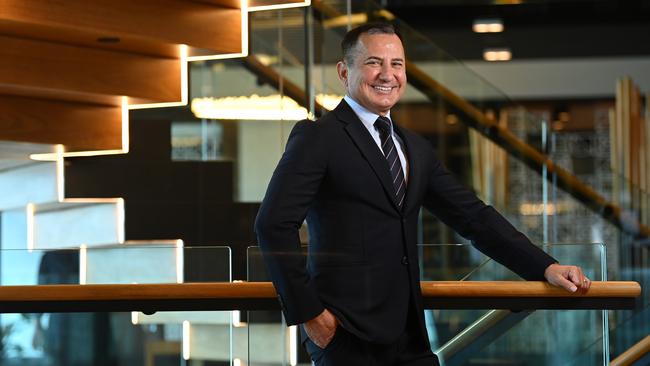
The Brisbane-based bank’s results for the six months ended February 28 showed net interest income dipped 2 per cent on the year earlier period, while non-interest income climbed 30 per cent and was boosted by a number of one-offs. Non-interest income typically reflects fees earned and in BoQ’s case the first half saw the bank book a termination fee from an insurance provider and incentive income from a card services contract.
The result was also helped by BoQ writing back expected loan losses due to better than anticipated outcomes in the Covid-19 wash up. The net interest margin – what the bank earns on loans minus funding and other costs – took a 12 basis point hit to reflect factors including writing a higher proportion of fixed rate loans.
The headline result was a 14 per cent rise in interim cash profit to $268m.
The acquisition of ME Bank was only a small positive as BoQ worked to get the portfolio back to loan growth after a period of going backwards. Expected deal synergies were raised to $95m in 2024, but investors will want real momentum to justify the hefty $1.33bn acquisition.
The bank’s overall housing and business lending portfolios did continue to outpace industry growth rates.
Still, investors would have been disappointed at the dividend payment and analysts raising questions about BoQ’s ability to earn more than its cost of capital in the future. BoQ’s shares dropped sharply by 6.3 per cent to $7.99 on Thursday, bucking a 0.6 per cent rise in the S&P/ASX200.
With some of the headwinds abating and the Reserve Bank expected to start raising interest rates in June, the pressure is now on BoQ to execute well by ensuring the ME loan growth is sustained and the bank is pursuing profitable growth.
Frazis told this column conditions in the last half were a “perfect storm” given volatile swap rates and a huge shift to less profitable fixed-rate mortgages, which at their peak accounted for 47 per cent of loans. That has since normalised – in line with funding costs and expectations of a rate hiking cycle – and Frazis says new loan applications are being fixed at a much lower rate of about 18 per cent of the total.
BoQ expects the RBA will begin lifting the cash rate in June, eventually taking it from a historic low of 0.1 per cent to about 1.75 per cent over 18 months.
Frazis says the RBA will take a measured approach and closely assess the impact of each rate rise on the economy, which has shown strength in rebounding from the Covid-19 lull.
“Unemployment down at 4 per cent is really incredible. And it really shows the resilience of the Australian economy … we’ve got a scenario now where unemployment is going to go below 4 per cent which is a great outcome,” he adds. The bank also highlighted a “large pipeline” of residential construction and infrastructure projects as boding well for the economy.
Frazis is bullish on business lending – particularly by medium-sized companies – which he says are exuding confidence and tend to be less impacted by rising interest rates. BoQ expects business credit growth of 8 per cent across the sector for the year ended August 31, and 6 per cent the following 12 months.
That compares to 7.5 per cent for housing credit growth in the 12 months ended August 31 and 4.5 per cent the following year.
BoQ’s digital transformation, including new banking apps, is a key part of Frazis’s pitch and analysts are closely watching guidance for at least a 1 per cent reduction in costs and for “positive jaws” where income growth exceeds costs by 2 per cent.
The digital push will need to yield results, resonate with customers and deliver profitable growth.
Frazis flagged he will outline a new strategy blueprint around mid year and sees BoQ having a cost-to-income ratio that is more akin to that of a major bank.
“We‘re digitising end-to-end our whole bank … at the end of that, we do get a step change in our cost-to-income ratio.”
Executive churn
On high levels of BoQ executive turnover, Frazis points to the bank’s performance and sidesteps the question of how important stability will be as he puts the finishing touches on his new strategy.
“If you look at our underlying performance, we’ve performed over five consecutive halves. Now that’s because we’ve got a really experienced executive leadership team, there’s a lot of depth, we’ve focused on capability on the execution side of that. And we’ve ensured that the mix and the capability we’ve got on exco (executive committee) is absolutely right for delivering the strategy,” he says.
BoQ’s finance boss Ewen Stafford is the latest to flag an exit from the bank after a string of executive changes over the past 18 months.
The respective heads of business and retail banking have changed and the former head of risk Adam McAnalen is on long service leave, with external appointment David Watts taking over that role.
BoQ had a CFO succession plan in place with deputy Racheal Kellaway moving into that seat in July, after a handover. Stafford joins Loan Market in July.








Bank of Queensland’s interim results were messy and included a lot of moving parts, but the real test for chief executive George Frazis emerges over the next two halves.